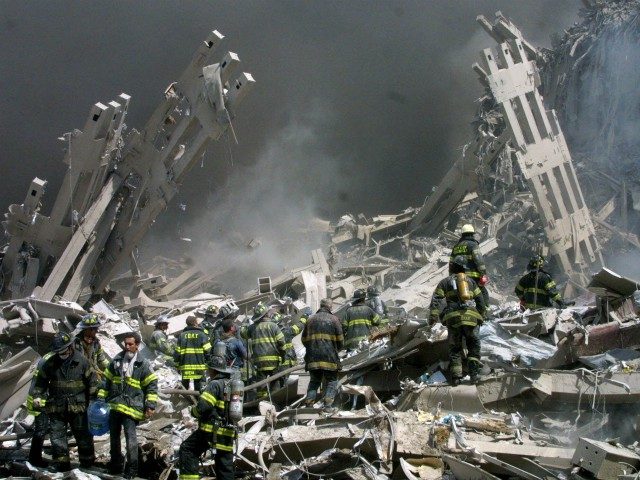Forensic scientists have yet to identify nearly 40 percent of the remains collected at the site of the September 11, 2001, attacks on the World Trade Center in New York.
This is a reminder of the difficulty of the challenge and the severity of destruction jihadists caused that day.
The Agence-France Presse (AFP) found the New York forensic team tasked with identifying remains hard at work this week, still trying to match family DNA to the bits and pieces of debris believed to have come from a human body at the site. While the team officially notified families in 2005 that their identification progress was likely over and those who had not received confirmation of relatives’ remains would likely never do so, the work continued, and today 1,642 of the 2,753 known victims in New York have been identified.
The AFP notes that the progress has slowed significantly since the early days, sometimes taking an entire year to identify one bit of remains, but the scientists working on the project remain committed, and the need for advanced technology to work on the project has helped advance the field of forensics significantly since 2001.
“Day in, day out, they repeat the same protocol dozens of times,” the AFP notes. “At first, they examine a bone fragment found in the wreckage of the Twin Towers. It has yet to be matched to DNA. Cut and ground to a fine dust, the remains are then mixed with two chemical products that can expose and then extract DNA.”
Among the major hurdles scientists face are the facts that, sometimes, the items believed to be human remains from the site are mixed with debris from the building, planes, or other materials and the fact that they have no DNA on file for the family of over one hundred people believed to have been present at the site. This results often in testing extracted DNA against no known relatives or wasting time trying to extra DNA from inanimate objects.
The total pieces of debris identified as human remains from the site stands at 22,000, according to AFP.
“The bone is the hardest biological material to work with and, on top of that, when they’re exposed to things that were present at Ground Zero, fire, mould, bacteria, sunlight, jet fuel, diesel fuel, all these destroy DNA,” Mark Desire, assistant director of forensic biology at the Office of Chief Medical Examiner in New York, told AFP. “So you could physically have a sample with very, very small amounts of DNA there.”
Yet the advances in science made at the facility, which works on other projects besides 9/11 remains identification, have made it a resource for forensic scientists around the world to come and study how to improve their practices.
This has been true for years, even as the pace of identification slows. In 2016, the 15th anniversary of the attacks, Desire told the New York Daily News that what researchers had learned on the 9/11 project had broader applications.
“We have been able to apply our techniques to cases around the world and help make identifications in everything from mass fatalities to missing person cases,” Desire said. “We’ve provided other agencies our techniques and they have able to use them to generate a DNA profile.”
At the time, the number of identified victims stood at 1,637, according to the Daily News, meaning another five people have been identified in the past two years.
The number of identified victims remains at an estimated 60 percent. Yet in 2005, experts estimated that, due to the extreme damage these bodies experienced, they would only be able to identify around 25 percent of the people affected.
“Nothing in the history of mass fatality events prepared America’s forensic community for the task of identifying those who died when terrorists attacked the World Trade Center in New York City on September 11, 2001,” author Nancy Ritter wrote in a 2007 study on the development of the 9/11 identification project. “The number of victims, the condition of their remains, and the duration of the recovery effort made their identification the greatest forensic challenge ever undertaken in this country.”
In the beginning, the forensics community chose to put together a Kinship and Data Analysis Panel (KADAP) made up of some of the nation’s most prominent experts in the field, Ritter narrates. W. Mark Dale, director of Forensic Services for the New York State Police, “asked the National Institute of Justice to create a ‘brain trust’ of independent scientists to offer guidance in this monumental task.”
“We needed human geneticists, statisticians, bioethicists, forensic DNA scientists/ managers, genetic researchers, information technologists, database managers, and program managers— and we needed them fast,” Dale told Ritter.
Experts believe that nearly 3,000 people died in the attacks on the World Trade Center, the Pentagon, and United Flight 93, which crashed in Shanksville, Pennsylvania, after passengers took control of the plane away from the al-Qaeda jihadists that had hijacked it. On Tuesday, Americans attended memorials around the country to commemorate the anniversary of their loss.

COMMENTS
Please let us know if you're having issues with commenting.